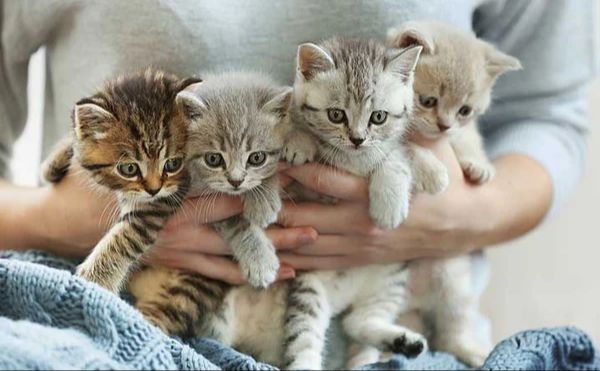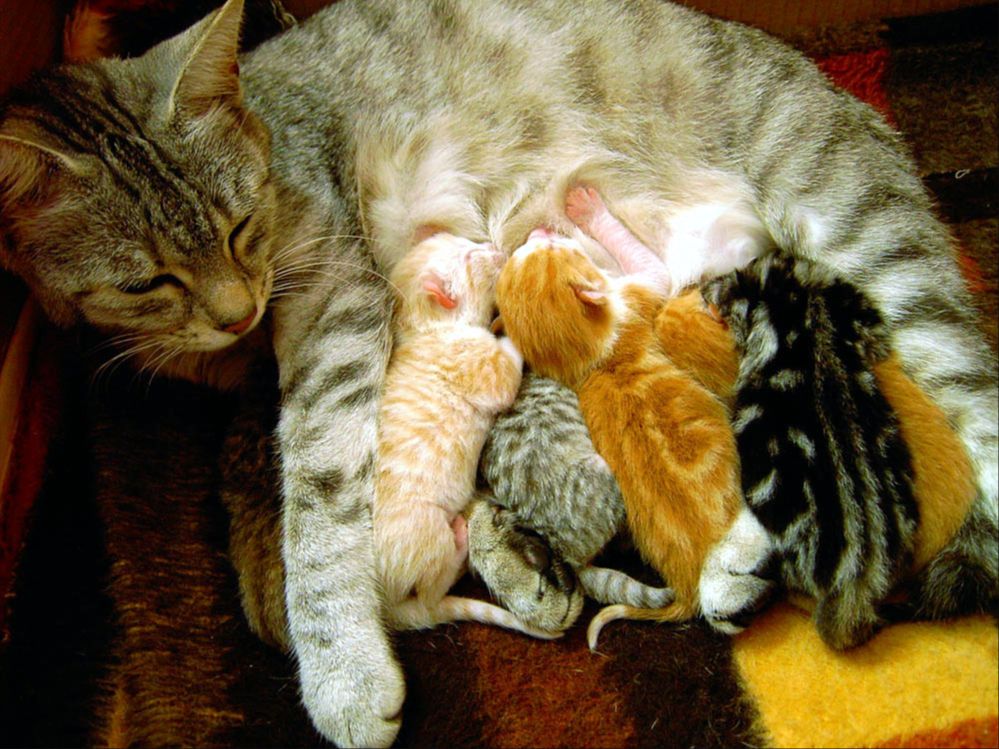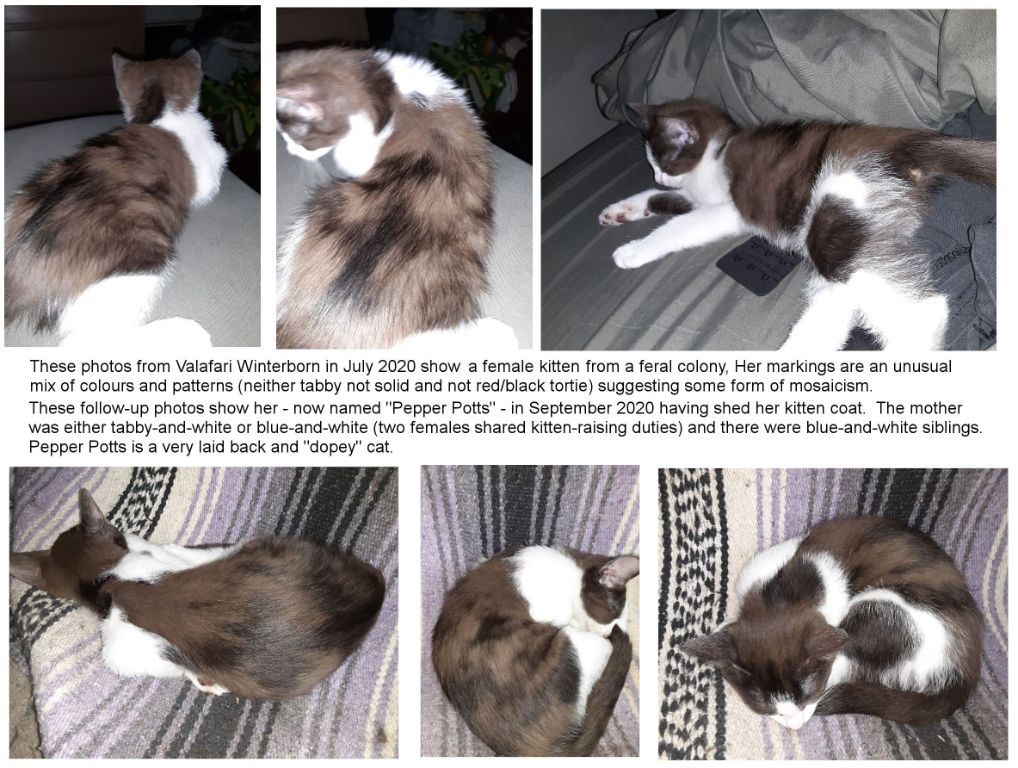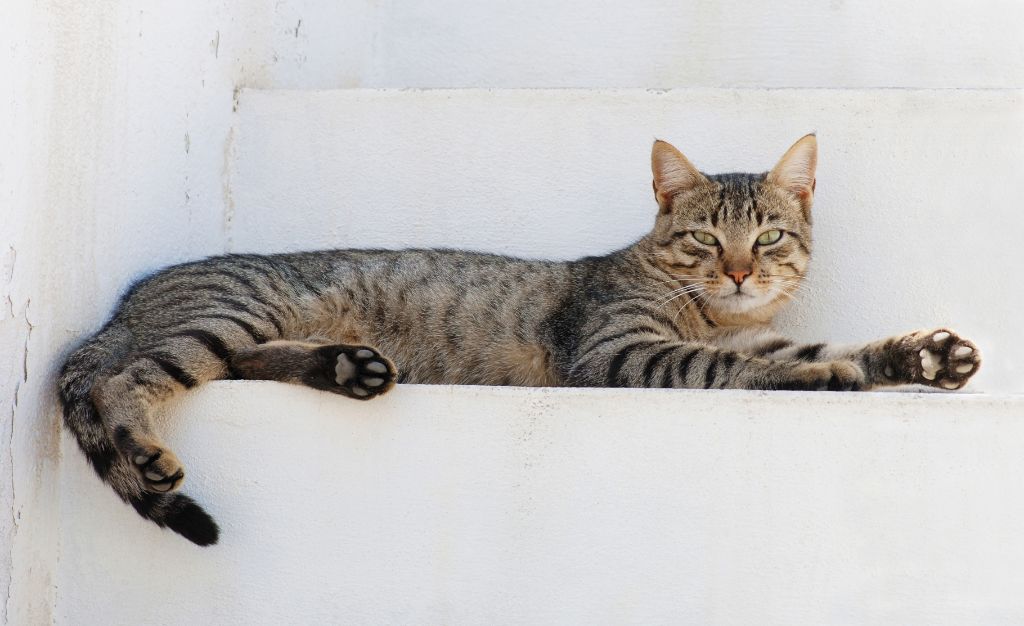It’s not uncommon for cat siblings from the same litter to look very different from one another. This often leaves cat owners wondering how cats that share the same parents and were born at the same time can have such drastic differences in their appearances.
In this article, we’ll explore why cat siblings can look so different, examining factors like having different fathers, coat colors and patterns, coat length and texture, eye colors, body size, and more. We’ll provide insight into the various genetic and environmental reasons that contribute to diversity among feline littermates.
Different Fathers
It is possible for a litter of kittens to have different fathers, a phenomenon known as superfecundation. This occurs when the female cat mates with multiple male cats while she is in heat before ovulation. Eggs released during a single estrous cycle can be fertilized by sperm from different males (Say, 1999).

During her fertile period, which lasts about 5-10 days, the female cat will usually mate multiple times with one or more males. Sperm can survive for up to 10 days inside the female reproductive tract. So if the female mates with Male A on Day 1 and Male B on Day 4, for example, she can become pregnant by both. The resulting litter may be fathered by Male A, Male B, or a mix of both (Catster, 2023).
Studies have found a high rate of multiple paternity in domestic cat litters, ranging from around 70-83%. So it is quite common for kittens born together to have different fathers (Say, 1999). This helps explain why cat siblings can display such varied physical traits.
Coat Colors and Patterns

Cat coat color and patterns are determined by several genes that control the distribution of melanin (pigment). The alleles of these genes can be dominant or recessive. A dominant allele will be expressed phenotypically even if only one copy is present. A recessive allele will only be expressed if two copies are present (homozygous).
For example, the B gene controls the presence of black pigment. The dominant allele B allows expression of black pigment. The recessive allele b inhibits black pigment. A cat with genotype BB or Bb will have a coat with black pigment, while a cat with genotype bb will not have black pigment.
Other key genes that control coat color include:
- A gene – Determines whether pigment is produced at all
- D gene – Dilutes black pigment to gray/blue
- O gene – Determines if a cat is orange or non-orange
- L gene – Causes streaks of white spotting
The combination and interaction of these genes produces the wide variety of cat coat colors and patterns we see.
Sources:
https://vgl.ucdavis.edu/resources/cat-coat-color
https://helorimer.people.ysu.edu/felgen.html
Coat Length
The length of a cat’s coat is determined by several genes. According to the Veterinary Genetics Laboratory at UC Davis, there are four known mutations that produce long hair in cats:

The first is the long hair gene, which is caused by a recessive mutation in the Fibroblast Growth Factor 5 (FGF5) gene. This mutation inhibits hair growth, resulting in a longer coat.
The second is the wire hair gene, caused by a dominant mutation in the Keratin 71 (KRT71) gene. This produces a coarse, wiry coat texture often seen in breeds like Cornish Rex.
The third is the wooly hair gene caused by a recessive mutation in Keratin 25 (KRT25) that results in a dense, wool-like coat seen in breeds like the Selkirk Rex.
The fourth is the rough coat gene caused by a dominant mutation in Lingol (LIPH) that causes a coarser, rougher coat texture.
In addition to these known gene mutations, other factors like nutrition, hormones, and seasonal changes can affect hair length in cats. But genetics play the primary role in determining whether a cat has long or short fur.
Coat Textures
Cats can have a wide variety of coat textures, which is another factor that contributes to siblings looking very different. Some common coat textures include:
- Short hair – Short, smooth fur that lies close to the body. Common in cats like Siamese.
- Medium hair – Slightly longer and fuller fur. Seen in breeds like American Shorthairs.
- Long hair – Long, flowing fur that forms a plush, thick coat. Persians and Maine Coons have long hair.
- Wire hair – Very coarse, crimped fur that is thick and dense. Associated with breeds like Cornish Rex.
- Silky hair – Extremely fine, smooth, and glossy fur. Oriental Shorthairs have a silky coat.
- Rex – Curly or wavy fur that forms tight curls. Devon Rex and Selkirk Rex have rex coats.
Even among purebred littermates, variations in coat length and texture can occur. Environmental factors like temperature can also affect coat texture – cats in colder climates may develop thicker, fluffier fur. Diet and grooming habits also play a role. So genetically related kittens can display noticeably different coat textures.
Eye Colors
A cat’s eye color is determined by genetics. The main gene responsible is the B gene, which codes for tyrosinase production. Tyrosinase is an enzyme involved in melanin pigment production. There are two alleles of the B gene: B, which produces tyrosinase and allows for melanin production, and b, which does not produce tyrosinase and prevents melanin production. The B allele is dominant over b.
Cats with two B alleles (BB) will have dark pigmented eyes, usually copper, hazel, green or blue. Cats with one B allele and one b allele (Bb) will also have pigmented eyes in shades of copper, hazel or green. Only cats with two b alleles (bb) will have blue eyes due to a lack of melanin. (Source: https://www.petforums.co.uk/threads/cat-eye-color-genetics.532757/)
The specific shade of eye color is also influenced by modifiers genes, like the C gene that dilutes black pigment to blue and the D gene that dilutes black pigment to amber/green. So kittens can inherit different combinations of the B, b, C and D genes from their parents, resulting in different eye colors and shades.
Body Size
The size differences between cat siblings can often be attributed to variations in their genes related to growth and development. Just like humans, cats have genes that influence their final adult size. One of the key genes is growth hormone (GH), which stimulates growth in young kittens. Kittens that inherit genes coding for higher levels of GH will tend to grow larger than their siblings.

In addition, genes influencing the sensitivity of tissues to GH also play a role. If tissues like bone and muscle are more sensitive to the effects of GH, they will grow and develop more in response to the same amount of hormone. This can result in larger overall body size. Different siblings may inherit different variations of the receptors that respond to GH, leading to divergent growth patterns.
Furthermore, the insulin-like growth factor 1 (IGF-1) gene also impacts size in cats. IGF-1 works with GH to stimulate growth. Higher levels of IGF-1 lead to increased growth, especially during the rapid growth phase in kittens. As with GH, differing versions of this gene inherited by siblings can change how much IGF-1 their bodies produce.
In summary, subtle variations in key genes influencing growth hormone levels, tissue sensitivities, and related factors contribute to often marked size differences between feline siblings. Their unique genetic makeups lead them to grow at different rates, resulting in divergent sizes despite shared parents and environment.
Facial Features
Cats typically display less variation in facial features compared to humans or dogs. This is largely due to differences in evolutionary history and selective breeding practices (https://www.quora.com/Why-do-cats-have-less-variations-in-facial-features-than-humans-or-dogs-do). However, there are some subtle differences in facial structure between individual cats and across breeds.
One study analyzed facial features of different cat breeds categorized as brachycephalic (short-muzzled), mesocephalic (medium-muzzled), and dolichocephalic (long-muzzled) (https://whatyourcatwants.com/cat-facial-expressions). It found that brachycephalic breeds like Persians tend to have more variability in features like eye opening and muzzle length compared to mesocephalic breeds. Dolichocephalic breeds like the Siamese showed the most diversity.
While the overall facial structure remains similar, subtle variances in the length and width of facial features like the muzzle, eyes, ears, and skull can distinguish individual cats. Environment and nutrition may also impact development of facial bones and muscles, causing slight natural variations.
So in summary, cat faces tend to be more uniform than other species, but distinctions in breed and individual development can lead to nuanced differences in facial proportions.
Environmental Factors
A cat’s appearance can also be influenced by environmental factors unrelated to genetics. Diet is one major factor that can affect coat health and appearance. Cats that eat a nutritious diet rich in proteins, fatty acids, and vitamins will generally have shinier, softer, and thicker fur. Deficiencies in certain nutrients like arginine can even cause fur loss or a dull coat. Whether a cat is allowed outdoors can also impact their coat, as exposure to the sun and elements may dry out or damage the fur over time.
Stress is another environmental factor that can affect appearance. Stress causes elevated cortisol levels, which can suppress the immune system and cause issues like hair loss, skin problems, and poor wound healing. Diseases, parasites, and other health issues triggered by stress may also show up visually through the coat or body condition. Additionally, overgrooming habits in stressed cats can thin out sections of fur or cause bald spots.
Even basic grooming habits like bathing frequency can physically alter the look of a cat’s coat texture and volume. And of course, traumatic injuries, burns, or surgeries can sometimes leave permanent cosmetic changes as well. So while genetics determine the baseline for a cat’s looks, environmental influences throughout life make a big impact too.
Conclusion
In conclusion, there are a number of factors that can lead to cat siblings in the same litter looking very different from one another. Genetics plays a major role, with differences in fathers, coat colors/patterns, coat textures, eye colors, and body size all being influenced by the kittens’ DNA. Even kittens with the same parents can have variations in their genes that lead to differences in their physical features. Beyond genetics, environmental factors like nutrition and socialization can also impact kittens’ development in subtle ways that make them unique. While cat siblings share a close bond, it’s amazing how much diversity there can be amongst littermates. Their wide range of appearances and traits are a testament to the complex combination of genetic and environmental variables that shape each kitten into a one-of-a-kind feline.

